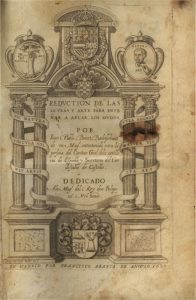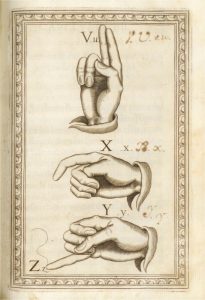Some of the most fascinating objects in the CID-Max A. Goldstein Collection in Speech and Hearing are works that contain examples of early modern manual alphabets. One of the most significant of these is Juan Pablo Bonet’s Reduction de las letras, y arte para enseñar a ablar los mudos (Simplification of the Letters of the Alphabet and Method of Teaching Deaf-mutes to Speak), published in Madrid in 1620. Bonet (1579-1633) entered the service of Juan Fernández de Velasco, the constable of Castile, in 1607, and after de Velasco’s death Bonet continued to be employed by de Velasco’s oldest son, Bernard Fernández. Bonet also became the teacher of de Velasco’s younger son, Louis, who went deaf at age two following a serious illness. One year after he took over Louis’ education, Bonet published his work on teaching the deaf to speak.[1] While the originality of the work is somewhat questionable – Bonet might have expanded on the earlier teachings of Pedro Ponce de León – it is still a significant early work on deaf education.
 It is also a rather lovely book to look at. As is common in Renaissance texts, the book’s title page contains a great deal of symbolism. The many heraldic devices include the arms of Juan Fernández de Velasco (directly above the line REDUCTION DE LAS), and the arms of the Kingdom of Castile and Leon (the tower quartered with the castle on the top left op the topmost badge). The two medallions at the top of each set of columns are particularly interesting. On the right, a boy is having his tongue freed from a padlock, which is surely a reference to the book’s theme of teaching the deaf to speak. The left medallion shows a bird flying toward two fledglings in a tree. It appears that maybe they were caged, and are now being set free. This could possibly be another visual metaphor for gaining the power of speech, and being set free from muteness.
It is also a rather lovely book to look at. As is common in Renaissance texts, the book’s title page contains a great deal of symbolism. The many heraldic devices include the arms of Juan Fernández de Velasco (directly above the line REDUCTION DE LAS), and the arms of the Kingdom of Castile and Leon (the tower quartered with the castle on the top left op the topmost badge). The two medallions at the top of each set of columns are particularly interesting. On the right, a boy is having his tongue freed from a padlock, which is surely a reference to the book’s theme of teaching the deaf to speak. The left medallion shows a bird flying toward two fledglings in a tree. It appears that maybe they were caged, and are now being set free. This could possibly be another visual metaphor for gaining the power of speech, and being set free from muteness.
 Bonet was primarily a proponent of oralism, meaning that his goal was to teach the deaf to speak, but his work also includes copperplate engravings of the manual alphabet, as seen on the right.
Bonet was primarily a proponent of oralism, meaning that his goal was to teach the deaf to speak, but his work also includes copperplate engravings of the manual alphabet, as seen on the right.
 One feature of the library’s copy of Bonet’s work is especially noteworthy is actually the endpapers! Endpapers are pages that are pasted to the inside covers of a book, and serve as a blank page before the text proper. Most of the endpapers in the rare book collections are plain, some are marbled, but these are shimmering gold foil.
One feature of the library’s copy of Bonet’s work is especially noteworthy is actually the endpapers! Endpapers are pages that are pasted to the inside covers of a book, and serve as a blank page before the text proper. Most of the endpapers in the rare book collections are plain, some are marbled, but these are shimmering gold foil.
[1] Biographical information from Marilyn Daniels’ Benedictine Roots in the Development of Deaf Education: Listening with the Heart (Westport: Bergin and Garvey, 1997): 21-23.
